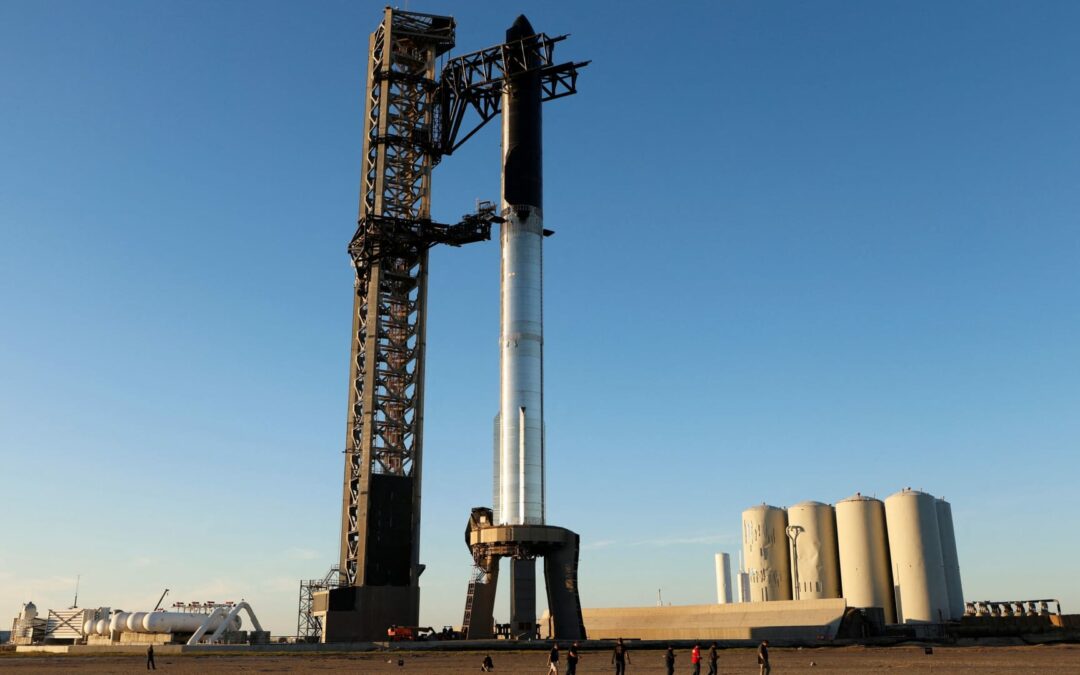SpaceX’s next-generation Starship spacecraft atop its powerful Super Heavy rocket is prepared for launch from the company’s Boca Chica launchpad on an uncrewed test flight, near Brownsville, Texas, U.S. November 15, 2023.
Joe Skipper | Reuters
SpaceX could attempt a key demonstration for NASA during the third test flight of its towering Starship rocket, according to the federal agency.
A NASA official revealed on Monday that the next Starship flight is expected to include “a propellant transfer demonstration,” though an agency spokesperson noted Tuesday the plan is subject to change, as is often the case in the space industry.
SpaceX last month launched its second Starship flight, a test which saw the company make progress in development of the monster rocket yet fall short of completing the full mission. The propellant transfer demonstration would require that the rocket reach orbit as one of the demo’s goals.
A successful attempt would push Starship beyond its benchmarks reached thus far.
“NASA and SpaceX are reviewing options for the demonstration to take place during an integrated flight test of Starship and the Super Heavy rocket. However, no final decisions on timing have been made,” NASA spokesperson Jimi Russell said in a statement to CNBC.
SpaceX did not respond to CNBC’s request for comment on the plans.
Sign up here to receive weekly editions of CNBC’s Investing in Space newsletter.
SpaceX CEO Elon Musk said shortly after November’s flight test that hardware for a third Starship launch “should be ready to fly in 3 to 4 weeks.” But that timeline depends on SpaceX’s review of the second flight’s data, preparations on the ground, as well as regulatory sign-off – the Federal Aviation Administration is overseeing a mishap investigation that must be complete before the company launches Starship again.
A key demonstration
The “propellant transfer demonstration” falls under a NASA “Tipping Point” contract worth $53.2 million that the agency awarded SpaceX in 2020. As part of the contract, NASA wants SpaceX to develop and test “Cryogenic Fluid Management” (CFM) technology, which the agency notes is essential for future missions to the moon and Mars.
Lockheed Martin and and United Launch Alliance were awarded with similar contracts, worth varying amounts.
Starship’s engines are powered by a combination of two propellants – liquid oxygen and liquid methane – that are kept at cryogenic temperatures.
Reaching orbit around the Earth requires using much of the propellant that was already loaded on the rocket, meaning SpaceX needs to refill Starship with more cryogenic propellant in order to deliver cargo to other planetary bodies.
That requires launching “Starship tankers” to deliver more propellant to orbit and transfer that propellant to the main Starship rocket. The process is similar to aerial refueling, a practice often used by the military to extend the range of jets.
Under the NASA contract, SpaceX’s first demo will involve transferring 10 metric tons of liquid oxygen between tanks within the Starship rocket. While Starship won’t be rendezvousing with another tanker rocket for this demo, NASA considers the test progress in maturing the tech.
“The goal is to advance cryogenic fluid transfer and fill level gauging technology through technology risk assessment, design and prototype testing, and in-orbit demonstration. The demonstration will decrease key risks for large-scale propellant transfer in the lead-up to future human spaceflight missions,” NASA says.
NASA has a major stake in the success of the Starship program, as SpaceX has a contract worth up to $4.2 billion to deliver astronauts to the moon with the rocket under the agency’s Artemis program.









